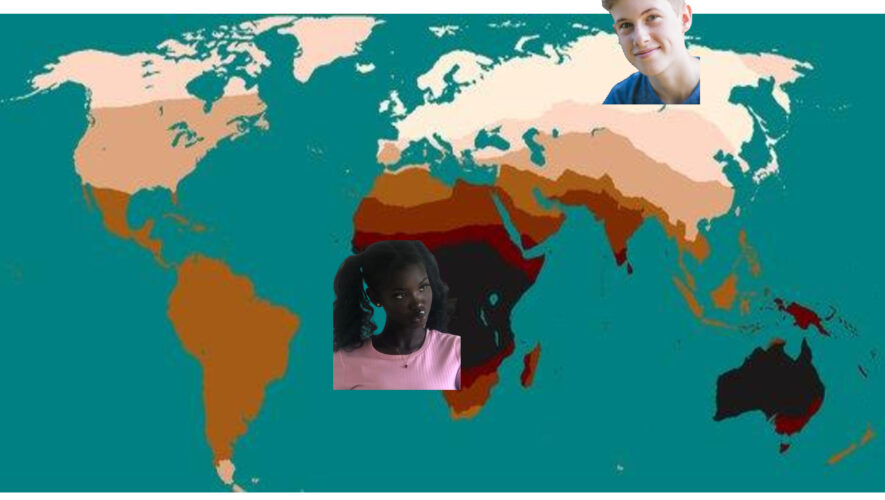The diversity of human skin colors is a beautiful representation of the complex and fascinating nature of our species. One of the most intriguing aspects of human skin color is how it changes over distance from the equator. From dark to light, the evolution of human skin color is a remarkable journey that reflects our history, biology, and culture. In this article, we will explore the science and mysteries of dark to light human skin over equator distance.
From darkness to light: human skin over equator
The equator is an imaginary line that divides the Earth into two halves. It is the closest point to the sun and receives the most direct sunlight. Human skin color changes dramatically as you move away from the equator. Near the equator, people have dark skin, while people in higher latitudes have lighter skin. The transition from dark to light skin over equator distance is a beautiful spectrum of colors that reflects the diversity of our planet.
Equator Distance and Skin Color: A Fascinating Journey
The journey from dark to light human skin is a fascinating one that involves a complex interplay of genetics, environment, and culture. As you move away from the equator, the intensity of the sun’s UV rays decreases. This reduces the need for melanin, the pigment that gives skin its color. So, people in higher latitudes have less melanin, which makes their skin lighter. However, this is not the only factor that determines skin color.
The Science Behind Dark to Light Human Skin
The science behind dark to light human skin is complex, and scientists are still unraveling its mysteries. The color of human skin is determined by the amount of melanin, the type of melanin, and the distribution of melanin in the skin. Melanin is produced by melanocytes, specialized cells in the skin. There are two types of melanin: eumelanin and pheomelanin. Eumelanin is responsible for dark skin, while pheomelanin is responsible for light skin.
Melanin, Sunlight, and Evolution
The evolution of human skin color is closely linked to the amount of sunlight that humans are exposed to. Sunlight is crucial for the production of vitamin D, which is necessary for healthy bones. However, too much sunlight can be harmful and cause skin cancer. So, over time, humans living near the equator evolved to have more melanin in their skin to protect them from the sun’s harmful rays. This adaptation provided an evolutionary advantage and allowed humans to thrive in the tropics.
The Evolutionary Advantage of Dark Skin Near the Equator
Dark skin near the equator is an evolutionary adaptation that has helped humans survive in the intense heat and strong UV rays of the tropics. Melanin acts as a natural sunscreen, protecting the skin from the harmful effects of the sun. It also helps prevent the breakdown of folic acid, a nutrient that is essential for fetal development. So, dark skin near the equator provides an evolutionary advantage that has allowed humans to thrive in this challenging environment.
The Mysteries of Light Skin in the Tropics
While dark skin near the equator has been extensively studied, the mysteries of light skin in the tropics are just beginning to be unraveled. Light skin in the tropics is an enigma because it provides less protection against the sun’s harmful rays. However, recent studies have shown that lighter skin in the tropics may be an adaptation to the low levels of vitamin D found in these regions. Lighter skin allows more sunlight to penetrate the skin, increasing the production of vitamin D.
Equator-Hopping: The Changing Colors of Human Skin
Equator-hopping is a term used to describe the changing colors of human skin as people migrate from the equator to higher latitudes. This journey results in a beautiful spectrum of skin colors that reflects the diversity of our planet. Equator-hopping has played a significant role in the evolution of human skin color and has contributed to the richness of human culture.
The Connection Between Skin Color and Vitamin D
Vitamin D is an essential nutrient that is produced when the skin is exposed to sunlight. However, people with dark skin near the equator may not get enough vitamin D from sunlight alone. This is because melanin reduces the amount of sunlight that penetrates the skin, which decreases the production of vitamin D. So, people with dark skin near the equator may need more vitamin D from their diet to stay healthy.
A Colorful World: Celebrating Diversity in Human Skin
The diversity of human skin color is a beautiful representation of the complexity of our species. It reflects our history, biology, and culture and serves as a reminder of the richness and beauty of human diversity. Celebrating diversity in human skin is essential to promoting a more inclusive and just world.
From Equator to Everywhere: A Rainbow of Human Skin Colors
From the equator to everywhere, human skin color is a beautiful spectrum of colors that reflects the diversity of our planet. The evolution of human skin color is a complex and fascinating journey that has played a significant role in the history and culture of our species. Embracing and celebrating the diversity of human skin colors is essential to promoting a more inclusive and just world.
The evolution of human skin color is a testament to the adaptability and resilience of our species. From dark to light, human skin over equator distance is a beautiful journey that reflects the diversity and richness of our planet. By celebrating the diversity of human skin colors, we can promote a more inclusive and just world that values the unique contributions of all people.







